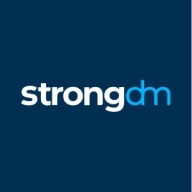

BeyondTrust Endpoint Privilege Management and StrongDM compete in the security sector, emphasizing privilege management and secure access. StrongDM appears to have the upper hand due to its comprehensive feature set, despite BeyondTrust's competitive pricing and support.
Features: BeyondTrust focuses on granular privilege controls, policy automation, and strong privilege containment. StrongDM offers secure access across multiple environments, versatile for hybrid setups, and seamless access control across diverse infrastructures, showcasing superior feature breadth.
Ease of Deployment and Customer Service: BeyondTrust provides both traditional on-premises and cloud deployment options with robust customer support. StrongDM offers a cloud-centric approach with easy deployment and streamlined customer service, giving it an edge in simplicity and quick setup.
Pricing and ROI: BeyondTrust is cost-effective and appeals to budget-conscious organizations with solid ROI. StrongDM, although more expensive, aligns its pricing with extensive capabilities, delivering a strong ROI through advanced management features. StrongDM's pricing is reflective of its feature richness, while BeyondTrust offers an affordable solution.
| Product | Market Share (%) |
|---|---|
| BeyondTrust Endpoint Privilege Management | 3.8% |
| StrongDM | 1.6% |
| Other | 94.6% |

| Company Size | Count |
|---|---|
| Small Business | 15 |
| Midsize Enterprise | 3 |
| Large Enterprise | 15 |
BeyondTrust Endpoint Privilege Management enables organizations to mitigate attacks by removing excess privileges on Windows, Mac, Unix/Linux and networked devices. Remove excessive end user privileges and control applications on Windows, Mac, Unix, Linux, and networked devices without hindering end-user productivity.
Key Solutions Include:
-ENTERPRISE PASSWORD SECURITY
Discover, manage and monitor all privileged accounts and SSH keys, secure privileged assets, and report on all privileged account activity in a single solution.
-ENDPOINT LEAST PRIVILEGE
Enforce least privilege across all Windows and Mac endpoints, gain visibility into target system vulnerabilities, and control access to privileged applications without disrupting user productivity or compromising security.
-SERVER PRIVILEGE MANAGEMENT
Gain control and visibility over Unix, Linux and Windows server user activity without sharing the root or administrator account.
-A SINGLE PLATFORM FOR MANAGEMENT, POLICY, REPORTING AND THREAT ANALYTICS
Utilize a single solution to manage PAM policies and deployment, understand vulnerability and threat analytics, and provide reporting to multiple stakeholders and complementary security systems.
Learn more at https://www.beyondtrust.com/privilege-management
StrongDM offers an innovative solution for managing infrastructure access, focusing on security and compliance while ensuring streamlined operations.
StrongDM simplifies infrastructure access by unifying management and auditing capabilities. It provides a seamless way for organizations to quickly secure sensitive data across all environments, enhancing access control without compromising efficiency. With a focus on integrating access data and compliance requirements, StrongDM is designed to meet the needs of security-conscious organizations.
What are standout features of StrongDM?In finance and healthcare industries, StrongDM is often implemented to safeguard sensitive information, ensuring compliance with stringent regulatory requirements. It provides an agile approach to access management, which is critical for sectors dealing with confidential data and strict compliance mandates.
We monitor all Privileged Access Management (PAM) reviews to prevent fraudulent reviews and keep review quality high. We do not post reviews by company employees or direct competitors. We validate each review for authenticity via cross-reference with LinkedIn, and personal follow-up with the reviewer when necessary.